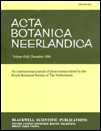KRITISCHE BEMERKUNGEN UND VORSCHLÄGE ZUR QUANTITATIVEN VEGETATIONSANALYSE
Abteilung des Laboratoriums für Pflanzensystematik and -Geographie der Landwirtschaftliche Hochschule Wageningen, Holland.
Abstract
Starting from the general principles of the Zürich-Montpellier school for the description of vegetation by means of field estimations of abundance, cover etc., the authors criticise the scales adopted by most workers, and some of their interpretations.
The following analytical characters of vegetation, and methods of estimation, are discussed: height (layering, recognition of synusiae), peripheral and internal cover, density, abundance, sociability, vitality, fertility, and phenological stage of taxa or layers. The main weaknesses of the usual scales for estimation of these characters (see list of references) are considered to be:
1. The use of combined scales for estimation of abundance and cover, and of vitality and fertility.
2. The lack of equivalence in the range of values for each class in most of the existing scales.
3. The limited range of some of the scales, and the absence of provision for more detailed estimations.
4. The inexact definition of degrees of abundance and sociability in the Braun-Blanquet scale.
5. The confusion about the concept of density.
A number of proposals is made for the use of scales with closer intervals, based on decimal, logarithmic or other systems. These leave less room for personal interpretation, and are more suitable for subsequent calculations and autecological studies. A method of reducing errors by carrying out certain estimations in two successive steps is suggested, e.g. by estimating peripheral and internal percentage cover (Fig. 1) separately and multiplying both values to obtain real cover.
The proposed scales have been tested in routine field work by the authors and other workers in a wide range of vegetation types. An example is given of an analysis of Dutch coastal sand dune vegetation in which some of the proposed scales have been applied.
The authors hope that their proposals for a more accurate description of vegetation will help to consolidate the basic principles underlying the Braun-Blanquet system of classification.




